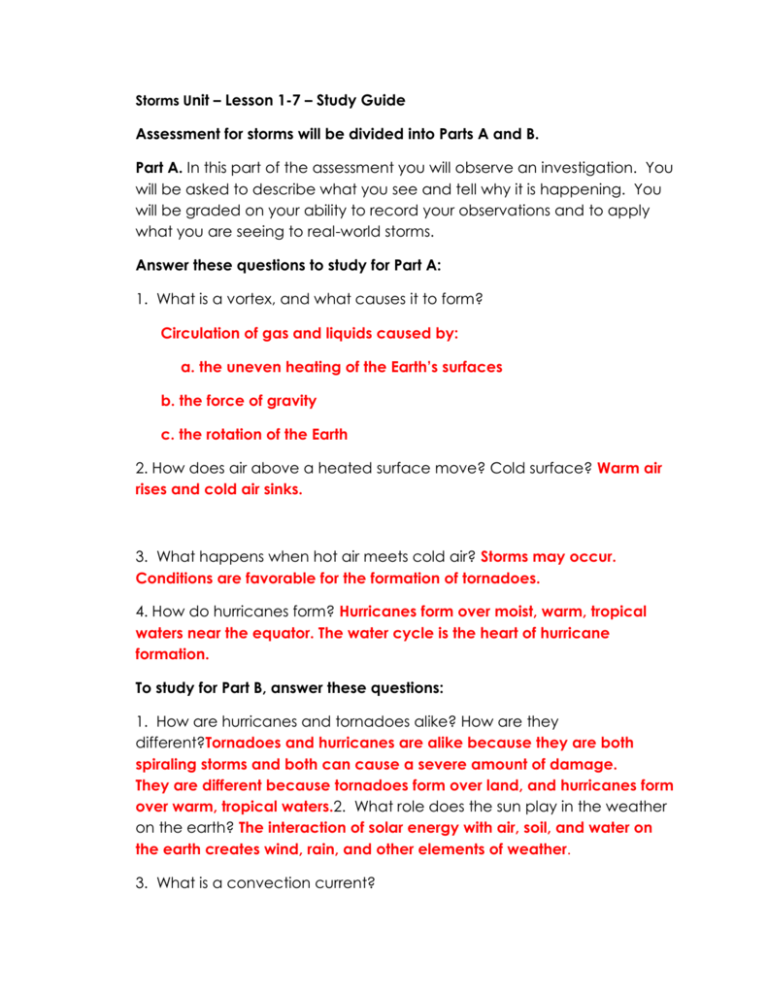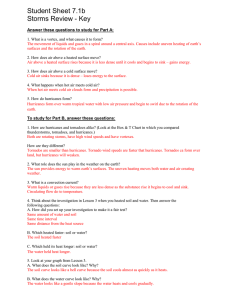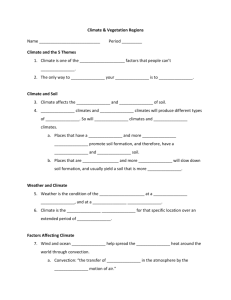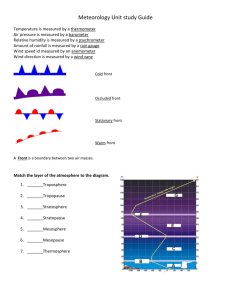Storms Unit – Lesson 1-7 – Study Guide
advertisement

Storms Unit – Lesson 1-7 – Study Guide Assessment for storms will be divided into Parts A and B. Part A. In this part of the assessment you will observe an investigation. You will be asked to describe what you see and tell why it is happening. You will be graded on your ability to record your observations and to apply what you are seeing to real-world storms. Answer these questions to study for Part A: 1. What is a vortex, and what causes it to form? Circulation of gas and liquids caused by: a. the uneven heating of the Earth’s surfaces b. the force of gravity c. the rotation of the Earth 2. How does air above a heated surface move? Cold surface? Warm air rises and cold air sinks. 3. What happens when hot air meets cold air? Storms may occur. Conditions are favorable for the formation of tornadoes. 4. How do hurricanes form? Hurricanes form over moist, warm, tropical waters near the equator. The water cycle is the heart of hurricane formation. To study for Part B, answer these questions: 1. How are hurricanes and tornadoes alike? How are they different?Tornadoes and hurricanes are alike because they are both spiraling storms and both can cause a severe amount of damage. They are different because tornadoes form over land, and hurricanes form over warm, tropical waters.2. What role does the sun play in the weather on the earth? The interaction of solar energy with air, soil, and water on the earth creates wind, rain, and other elements of weather. 3. What is a convection current? The circulating flow of air resulting from temperature differences is called a convection current. 4. Think about the investigation in Lesson 3 when you heated soil and water. Then answer the following questions: A. How did you set up your investigation to make it a fair test? Soil and water the same distance from the lamp. Thermometers were of equal depth in the soil and water. Same amount of soil and water in each beaker. The lamp was on the same amount of time and off the same amount of time for the soil and water. B. Which heated faster: soil or water? Soil heated up faster. C. Which held its heat longer: soil or water? The soil cooled down faster than the water so the water held its heat longer. 5. Look at your graph from Lesson 3. A. What does the soil curve look like? Why? B. What does the water curve look like? Why? C. What was the temperature of your soil after 5 minutes of heating? 6. Study the illustration of Tornado Alley on page 65. Answer the following: A. What states make up Tornado Alley? Texas, Kansas, Oklahoma, and Missouri B. What causes tornadoes to form in Tornado Alley? When cold, dry air from the Rockies and Canada meets warm, moist air from the Gulf of Mexico, conditions are favorable for tornadoes to form. 7. Take another look at the illustration of a sea breeze and a land breeze on pg. 59. What is a sea breeze, and when does it form? What is a land breeze, and when does it form? Sea breeze- circulating flow of air from the water to the land (day). Land breeze- circulating flow of air from the land to the water (night). 8. Look at the illustration of the water cycle on page 72. Describe the water cycle and how clouds form? 1. Water evaporates from the Earth’s surface as it changes from a liquid to a gas (water vapor). 2. It rises with warm air. 3. The water vapor along with dust particles cool at higher altitudes and it condenses into drops of water that form clouds. Clouds can form in a low pressure system. 9. Look at the weather maps on page 70. A. Where is the pressure high? What is the weather like there? High Pressure systems are located in the western U.S., the Gulf of Mexico, and in the Northeast United States. Weather here will be calm, clear skies, and sunny. B. Where is the pressure low? What is the weather like there? Pressure is low in the upper northwest and in New Mexico. The weather here is stormy and cloudy. C. Find a front. Where is it? What is the weather like there? There is a front going from the north all the way down through Colorado, New Mexico, and Arizona. To the west of the front is stormy and rainy and to the east of the front, you have clear and calm weather. D. In what direction is the weather moving across the United States? How can this help meteorologists? The weather typically moves from the west to the east helping meteorologists to better predict the path that severe weather may take. 10. Think about the investigation in Lesson 7 in which you modeled ocean currents. A. How do some deep ocean currents form? Deep ocean currents can form due to differences in water density. Upwellings and downwellings play an important role in the movement of deep ocean currents. B. How do winds affect ocean water? Wind blowing over the ocean can cause surface currents. C. How do ocean currents affect air temperatures around the world? The Gulf Stream for example is a warm water current that can cause temperatures to increase by carrying that warm water to areas that otherwise would be cooler. (Great Britain). \






